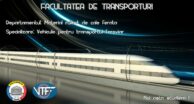Metodă de reducere a vibrațiilor verticale ale cutiei vehiculelor feroviare bazată pe un sistem anti-încovoiere
Cerințele tot mai exigente legate de sporirea vitezei de circulație, reducerea consumului de energie și a costurilor de fabricație au impus un criteriu de bază al proiectării vehiculelor feroviare – reducerea greutății, în particular reducerea greutății cutiei. Cu cât cutia vehiculului devine mai uşoară, flexibilitatea acesteia creşte, lucru care permite excitarea cu uşurinţă a vibraţiilor structurale ale cutiei. Numeroase studii teoretice și experimentale au demonstrat faptul că vibrațiile structurale ale cutiei vehiculului feroviar afectează confortul vibratoriu atât la trenurile de mare viteză, cât şi la cele pentru trafic suburban sau la trenurile de metrou. Vibrațiile structurale ale cutiei sunt deosebit de complexe, însă cea mai mare influenţă asupra confortului vibratoriu o are primul mod de încovoiere verticală a cutiei, a cărui frecvenţă poate să se situeze în anumite condiţii în intervalul de frecvenţă în care organismul uman prezintă o sensibilitate mai mare la vibraţiile verticale. Scopul acestui proiect este de a testa experimental o nouă metodă de reducere a vibrațiilor verticale de încovoiere ale cutiei vehiculelor feroviare. Metoda se bazează pe o abordare inovativă care presupune utilizarea unui sistem pasiv care are rolul de a limita rotaţia secţiunilor transversale ale cutiei cauzată de vibrația de încovoiere. Acest sistem constă în două bare cu secțiune circulară, denumite bare anti-încovoiere, montate pe lonjeroanele laterale ale şasiului cutiei. Avantajul metodei propuse constă în faptul că parametrii barei anti-încovoiere se stabilesc din condiţia de realizare a unei anumite frecvenţe a primului mod de încovoiere verticală a cutiei, convenabilă din punctul de vedere al confortului vibratoriu. Cu alte cuvinte, frecvența proprie a încovoierii cutiei poate fi crescută și adusă în afara domeniului de frecvență în care corpul uman prezintă sensibilitate ridicată la vibrații, fără creșteri importante ale masei cutiei.
Method to reducing the vertical vibration of the railway vehicle car body based on anti-bending system
The more and more demanding requirements linked to increasing velocities, reduction the energy consumption and the manufacturing costs have enforced a basic criterion of designing the railway vehicles – a lower weight of the vehicle, mainly of the car body that holds the largest proportion in the total weight of the vehicle. The lighter the car body of the vehicle, the higher its flexibility, thus allowing an easy excitation of the car body structural vibrations. A large number of theoretical and experimental studies have validated the fact that the car body structural vibrations have a great impact on the ride comfort in both the high speed trains, suburban or subway trains. The car body structural vibrations is very complex, but the highest influence on the ride comfort comes from the first car body eigenmode of vertical bending, whose frequency can fall into the range where the human body shows a higher sensitivity to the vertical vibrations. The purpose of this project is to test experimentally a new method to reducing the vertical bending vibrations of the railway vehicles car body. The method relies on an innovative approach that implies the use of a passive system with the role to limit the rotation of the car body cross-sections caused by the bending vibration. This system consists of two bars with circular section, called anti-bending bars, fixed to the longitudinal beams of a car body underframe. The advantage of the method being proposed consists in the fact that the anti-bending bar parameters are determined from the requirement of reaching a certain frequency of the first vertical bending mode of the car body, convenient from the ride comfort perspective. In other words, the eigenfrequency of the car body bending can be increased and taken out from the frequency range where the human body shows a high sensitivity to vibrations, with no significant raise in the car body mass.
